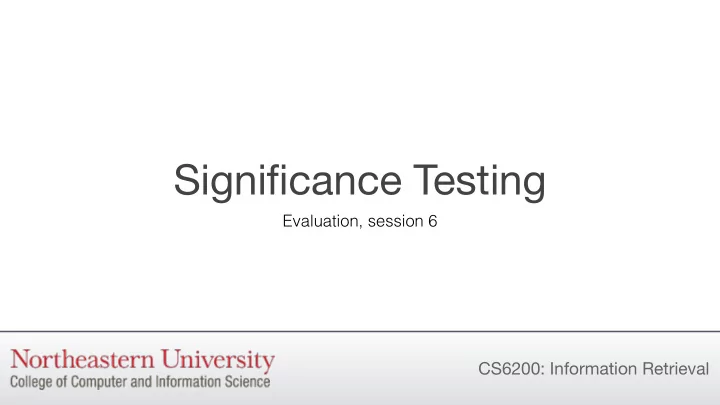

Significance Testing Evaluation, session 6 CS6200: Information Retrieval
Statistical Significance IR and other experimental sciences are concerned with measuring the effects of competing systems and deciding whether they are really different. For instance, “Does stemming improve my results enough that my search engine should use it?” Statistical hypothesis testing is a collection of principled methods for setting up these tests and making justified conclusions from their results.
Hypothesis Testing In statistical hypothesis testing, we try to isolate the effect of a single change so we can decide whether it makes an impact. Null Hypothesis: what we believe by The test allows us to choose between the default – the change did not improve null hypothesis and an alternative hypothesis . performance. The outcome of a hypothesis test does Alternative Hypothesis: the change not tell us whether the alternative improved performance. hypothesis is true. Instead, it tells us the probability that the null hypothesis could The hypotheses we’re testing produce a “fake improvement” at least as extreme as the data you’re testing.
Test Steps 1. Prepare your experiment carefully, with only one difference between the two systems: the change whose effect you wish to measure. Choose a significance level ⍺ , used to make your decision. 2. Run each system many times (e.g. on many different queries), evaluating each run (e.g. with AP). 3. Calculate a test statistic for each system based on the distributions of evaluation metrics. 4. Use a statistical significance test to compare the test statistics (one for each system). This will give you a p-value : the probability of the null hypothesis producing a difference at least this large. 5. If the p-value is less than ⍺ , reject the null hypothesis. The probability that you will correctly reject the null hypothesis using a particular statistical test is known as its power .
Error Types Hypothesis testing involves balancing between two types of errors: • Type I Errors , or false positives, occur when the null hypothesis is true, but you reject it • Type II Errors , or false negatives, occur when the null hypothesis is false, but you don’t reject it. The probability of a type I error is ⍺ – the significance level. The probability of a type II error is β = ( 1 - power ) .
What Can Go Wrong? The power of a statistical test depends on: • The number of independent runs (e.g. queries). In IR, we generally use 50 queries, but empirical studies suggest that 25 may be enough. • Any bias in the experimental setup (are you using the wrong test collection?). • Whether the true distribution of test statistic values matches the distribution assumed by your statistical test. A common mistake is repeating a test until you get the p-value you want. Repeating a test decreases its power.
Wrapping Up For a very clear and detailed explanation of the subtleties of statistical testing, see the excellent guide “Statistics Done Wrong,” at: http://www.statisticsdonewrong.com. In the next two sessions, we’ll look at two specific significance tests.
Recommend
More recommend